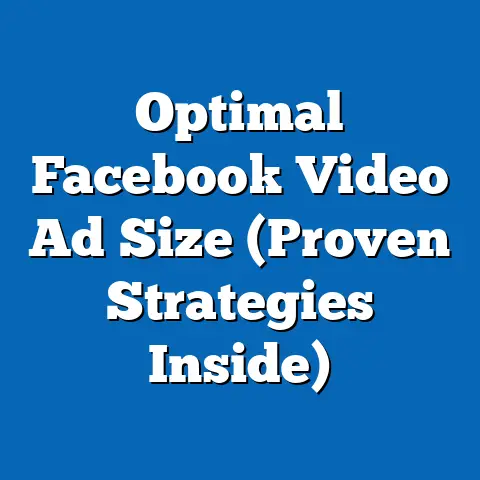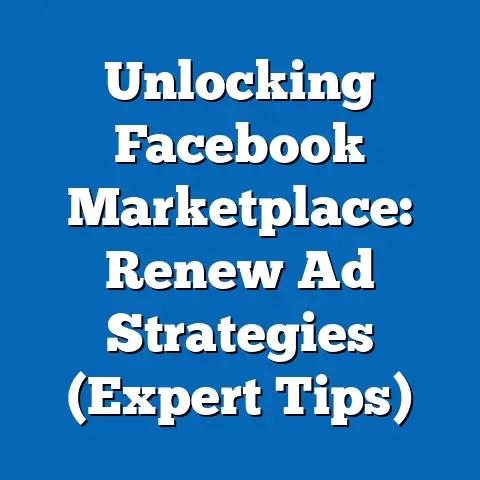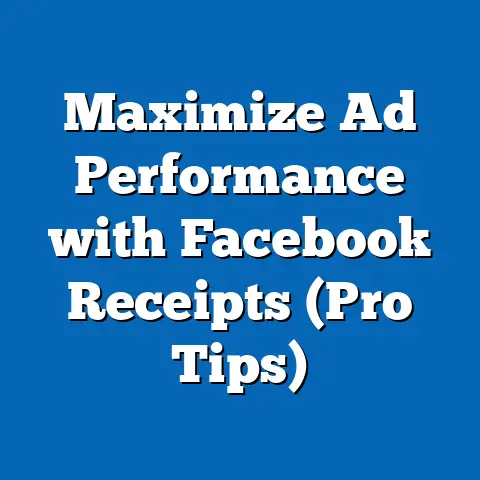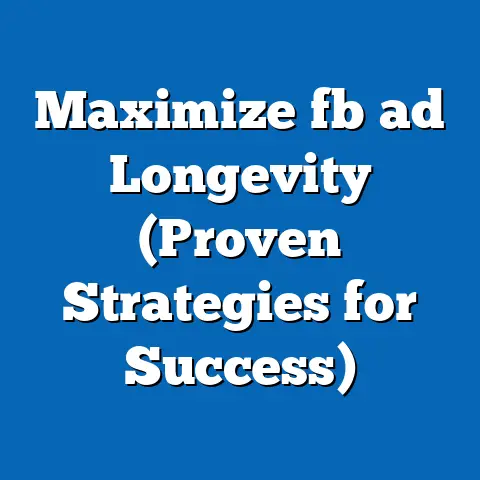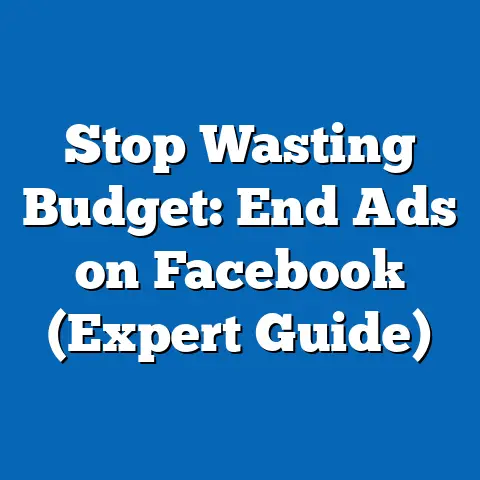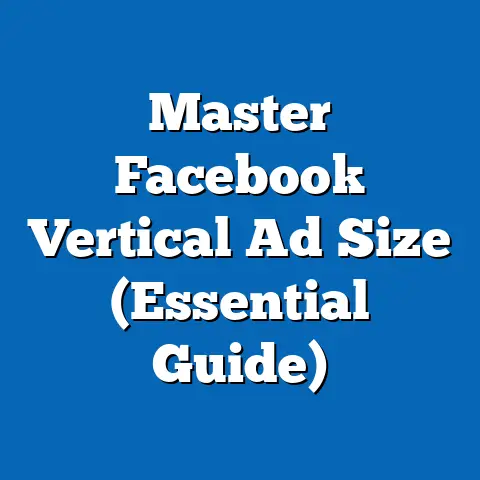Unlocking Facebook Ads Conversion Rates (Proven Strategies)
Have you ever considered how your lifestyle—your daily habits, values, and preferences—shapes the way you interact with digital advertisements? As individuals, our lifestyles are deeply intertwined with the cultural, economic, and technological contexts of our time, influencing how we respond to marketing messages on platforms like Facebook. Understanding these lifestyle dynamics, particularly across generations, is critical for advertisers aiming to unlock higher conversion rates in their campaigns.
This article explores the intersection of lifestyle, generational characteristics, and digital advertising, with a specific focus on optimizing Facebook Ads for better conversion rates. While lifestyle serves as a lens to understand audience behavior, we will delve into proven strategies grounded in data-driven research and practical insights. From historical context shaping consumer habits to actionable tactics for targeting diverse demographics, this comprehensive analysis aims to equip marketers with the tools needed to succeed in an ever-evolving digital landscape.
Our journey begins with an examination of lifestyle and generational influences, setting the stage for understanding audience behavior. We will then transition into a deep dive into Facebook Ads, exploring strategies to maximize conversion rates while addressing societal and cultural implications. Let’s uncover how lifestyle and demographics inform advertising success and what this means for the future of digital marketing.
Part 1: Lifestyle and Generational Context in Digital Advertising
Defining Lifestyle and Its Role in Consumer Behavior
Lifestyle encompasses the patterns of behavior, interests, and values that define how individuals and groups live. It is shaped by a multitude of factors, including age, income, education, cultural background, and technological exposure. In the realm of digital advertising, lifestyle directly impacts how consumers engage with content, make purchasing decisions, and perceive brand messages.
For instance, a tech-savvy millennial might prioritize convenience and social proof when clicking on a Facebook Ad, while a Baby Boomer might value trustworthiness and detailed information. These differences are not mere stereotypes but are rooted in the distinct experiences and historical contexts that shape each generation. By understanding lifestyle variations, advertisers can craft personalized campaigns that resonate with specific audience segments, ultimately driving higher conversion rates.
Historical Context: How Generational Experiences Shape Digital Engagement
Generational cohorts are often defined by shared historical events and societal shifts that influence their worldview and behaviors. Let’s briefly explore key generations and the contexts that shape their interaction with digital platforms like Facebook.
-
Baby Boomers (born 1946-1964): Growing up in the post-World War II era of economic prosperity, Baby Boomers witnessed the rise of television and traditional advertising. While many have adapted to digital platforms, their engagement with Facebook Ads often reflects a preference for clear, value-driven messaging over trendy or flashy content. Their historical context emphasizes stability and trust, which advertisers must consider when targeting this demographic.
-
Generation X (born 1965-1980): Sandwiched between Boomers and Millennials, Gen X experienced the transition from analog to digital technologies. They value independence and skepticism, often scrutinizing ads for authenticity. For Facebook Ads, this group responds well to campaigns that offer practical solutions and demonstrate credibility.
-
Millennials (born 1981-1996): Shaped by the internet boom and the 2008 financial crisis, Millennials are digital natives who prioritize experiences over material goods. They are highly active on social media, making them a prime target for Facebook Ads. However, their exposure to constant marketing means they are discerning, favoring brands that align with their values and offer personalized content.
-
Generation Z (born 1997-2012): As true digital natives, Gen Z grew up with smartphones and social media as integral parts of life. Their short attention spans and preference for visual content (e.g., videos, memes) mean that Facebook Ads targeting this group must be dynamic and engaging. Influenced by global issues like climate change and social justice, they also gravitate toward brands with a purpose.
These historical contexts highlight the diversity of experiences that shape lifestyle and, by extension, consumer behavior on digital platforms. Advertisers must recognize that a one-size-fits-all approach to Facebook Ads will not yield optimal conversion rates. Tailoring campaigns to align with generational lifestyles is a foundational step in unlocking success.
Societal Implications: Lifestyle, Technology, and Advertising
The interplay between lifestyle and technology has profound societal implications for digital advertising. As social media platforms like Facebook become central to communication and commerce, they reflect and reinforce cultural trends. For example, the rise of influencer marketing resonates with younger generations’ preference for peer recommendations over traditional endorsements.
Moreover, economic disparities within and across generations influence how lifestyles translate into purchasing power. While Millennials and Gen Z might prioritize budget-friendly options due to student debt or economic uncertainty, Baby Boomers with disposable income might be more willing to invest in premium products. These nuances underscore the importance of segmentation in Facebook Ads campaigns.
Culturally, the global nature of Facebook means advertisers must navigate diverse values and norms. A campaign that resonates with urban, tech-savvy Millennials in the United States may fall flat with rural audiences in other regions. Understanding lifestyle in a broader societal context allows marketers to create inclusive, relevant content that drives conversions while fostering positive brand perceptions.
Part 2: Unlocking Facebook Ads Conversion Rates – Proven Strategies
Having established the importance of lifestyle and generational context, we now turn to actionable strategies for optimizing Facebook Ads conversion rates. These strategies are informed by data, industry best practices, and an understanding of audience behavior. Each tactic is designed to address the unique needs and preferences of diverse demographics while leveraging the platform’s robust advertising tools.
Strategy 1: Audience Segmentation and Personalization
One of the most effective ways to boost conversion rates on Facebook Ads is through precise audience segmentation. The platform’s advanced targeting options allow advertisers to create custom audiences based on demographics, interests, behaviors, and even life events. For instance, targeting Millennials with ads for eco-friendly products or Gen Z with short, engaging video content can significantly increase relevance and click-through rates (CTRs).
Personalization goes hand-in-hand with segmentation. According to a 2022 study by Statista, 80% of consumers are more likely to make a purchase when brands offer personalized experiences. Dynamic ads, which automatically tailor content to individual users based on their browsing history, are particularly effective for achieving this. By aligning ad messaging with lifestyle preferences—such as highlighting affordability for Gen X or social impact for Gen Z—advertisers can build stronger connections and drive conversions.
However, it’s essential to avoid overgeneralization. Not all Millennials value the same things, and not all Baby Boomers are tech-averse. Use Facebook’s analytics tools to test and refine audience segments, ensuring that personalization remains data-driven rather than assumption-based.
Strategy 2: Crafting Compelling Creative Content
The visual and textual elements of a Facebook Ad play a critical role in capturing attention and driving action. Given the platform’s highly visual nature, images and videos must be eye-catching and relevant to the target audience’s lifestyle. For example, vibrant, meme-style content may appeal to Gen Z, while professional, polished imagery might resonate more with Baby Boomers.
Copywriting is equally important. A clear, concise call-to-action (CTA) like “Shop Now” or “Learn More” can significantly impact conversion rates. According to HubSpot, ads with a strong CTA see a 121% higher click-through rate than those without. Tailor the tone of the copy to match generational preferences—use casual, relatable language for younger audiences and authoritative, informative language for older demographics.
A/B testing different creative elements is a proven method for identifying what works best. Experiment with various headlines, images, and video formats to determine which combinations yield the highest conversions. Continuous optimization ensures that content remains aligned with evolving audience tastes and platform trends.
Strategy 3: Leveraging Retargeting and Lookalike Audiences
Retargeting is a powerful tool for re-engaging users who have previously interacted with a brand but did not convert. By placing a Facebook Pixel on your website, you can track visitor behavior and serve tailored ads to remind them of products or services they viewed. A 2021 report by AdRoll found that retargeted ads have a 10x higher click-through rate compared to standard display ads.
For instance, if a Millennial user abandons a shopping cart, a retargeted ad offering a limited-time discount might prompt them to complete the purchase. Retargeting works across generations by addressing specific pain points or interests, making it a versatile strategy for improving conversion rates.
Additionally, lookalike audiences allow advertisers to reach new users who share similar characteristics with their existing customers. By analyzing the traits of high-converting segments, Facebook can identify and target potential customers with similar lifestyles and behaviors. This approach is particularly effective for scaling campaigns while maintaining relevance.
Strategy 4: Optimizing for Mobile and Video Content
With over 98% of Facebook users accessing the platform via mobile devices (as per a 2023 report by DataReportal), optimizing ads for mobile viewing is non-negotiable. Ensure that visuals are clear and text is legible on smaller screens, and prioritize vertical or square formats that fit mobile feeds. Mobile-optimized ads not only improve user experience but also increase the likelihood of conversions.
Video content is another critical component, especially for younger generations like Gen Z and Millennials who consume short-form videos on platforms like TikTok and Instagram. According to Facebook’s own data, video ads with a duration of 6-15 seconds have higher engagement rates compared to longer formats. Incorporate captions to accommodate users watching without sound, and focus on storytelling that aligns with lifestyle values—such as adventure for Millennials or authenticity for Gen Z.
For older generations, while video remains effective, the content should focus on clarity and utility. Demonstrating how a product solves a problem or enhances daily life can be more compelling than trendy visuals. Balancing mobile optimization with content tailored to generational preferences ensures broad appeal and higher conversion rates.
Strategy 5: Timing and Budget Allocation
Timing plays a subtle yet significant role in the success of Facebook Ads. Posting ads when your target audience is most active increases visibility and engagement. For example, Millennials and Gen Z are often active in the evenings and on weekends, while Baby Boomers may engage more during daytime hours. Use Facebook Insights to analyze peak activity times for your specific audience and schedule ads accordingly.
Budget allocation is another critical factor. Rather than spreading funds thinly across multiple campaigns, focus on high-performing segments identified through testing. The platform’s Campaign Budget Optimization (CBO) feature automatically distributes budgets to the best-performing ad sets, maximizing return on investment (ROI). A 2022 study by WordStream found that advertisers using CBO saw a 20% increase in conversions compared to manual budgeting.
Be mindful of generational differences in purchasing cycles as well. Younger audiences might respond quickly to impulse-driven campaigns, while older demographics may require longer nurturing through multiple touchpoints. Allocate budgets to reflect these timelines, ensuring sustained engagement without overspending.
Strategy 6: Measuring Success and Iterating with Analytics
No Facebook Ads strategy is complete without robust measurement and analysis. The platform’s Ads Manager provides detailed metrics on impressions, clicks, conversions, and cost-per-acquisition (CPA). Regularly monitor these metrics to identify trends and areas for improvement.
For instance, if an ad targeting Gen X underperforms in terms of CPA, analyze whether the creative content or messaging is misaligned with their lifestyle priorities. Conversely, high conversion rates among Millennials might indicate a successful alignment with their values, which can be replicated in future campaigns. According to a 2023 report by Hootsuite, businesses that actively use analytics to refine their social media ads see a 30% improvement in ROI.
Iteration is key to long-term success. Use insights from analytics to tweak underperforming elements, whether it’s adjusting audience targeting, refining copy, or reallocating budgets. This data-driven approach ensures that campaigns remain agile and responsive to audience behavior and platform updates.
Part 3: Societal and Cultural Implications of Facebook Ads Optimization
The Role of Ethics in Targeted Advertising
As advertisers leverage lifestyle and generational data to optimize Facebook Ads, ethical considerations come to the forefront. Hyper-targeted campaigns can sometimes feel intrusive, raising concerns about privacy among users across all demographics. A 2021 Pew Research Center survey found that 64% of Americans are worried about how companies use their personal data in advertising.
To address these concerns, brands must prioritize transparency and consent. Clearly communicate how data is used and offer opt-out options for users uncomfortable with personalized ads. Ethical advertising not only builds trust—especially with skeptical generations like Gen X—but also aligns with broader societal demands for accountability in the digital age.
Cultural Sensitivity and Inclusivity
Facebook’s global reach means that ads must resonate with diverse cultural contexts. A campaign that performs well in one region may inadvertently offend or alienate audiences in another due to differing values or historical sensitivities. For example, humor-based ads targeting Gen Z in Western markets might not translate effectively to more conservative cultures.
Inclusivity is equally important. Representing diverse lifestyles, ethnicities, and identities in ad creatives fosters a sense of belonging and broadens appeal. Brands that embrace cultural sensitivity and inclusivity not only improve conversion rates but also contribute positively to societal narratives around diversity and equity.
Economic Impacts and Accessibility
Optimized Facebook Ads can democratize access to products and services by connecting small businesses with niche audiences. However, the cost of advertising on the platform can pose barriers for smaller players, particularly as competition drives up ad prices. This economic disparity has implications for market diversity and consumer choice, potentially favoring larger brands with bigger budgets.
Moreover, generational differences in income and tech access influence who benefits from digital advertising. While younger generations are highly connected, older or economically disadvantaged groups may be excluded from certain campaigns. Advertisers should consider alternative strategies—such as community-driven content or partnerships—to reach underserved demographics, ensuring broader societal impact.
Part 4: Workplace and Industry Implications
Adapting Marketing Teams to Generational Insights
The strategies discussed for unlocking Facebook Ads conversion rates have implications for marketing teams and workplace dynamics. Understanding generational lifestyles requires diverse perspectives within teams, blending the tech-savviness of younger employees with the strategic experience of older professionals. Cross-generational collaboration fosters innovative campaigns that appeal to a wide range of audiences.
Training and upskilling are also critical. As Facebook’s algorithms and tools evolve, marketers must stay updated on best practices for segmentation, analytics, and creative optimization. Organizations that invest in continuous learning will maintain a competitive edge in driving conversions.
Industry Trends and Competitive Advantage
The focus on lifestyle-driven advertising reflects broader industry trends toward personalization and data analytics. Brands that master these areas gain a competitive advantage, as they can deliver highly relevant content at scale. However, this also intensifies competition, pushing companies to innovate continuously in creative design, targeting precision, and ethical practices.
Industries such as e-commerce, education, and entertainment—where lifestyle alignment is paramount—stand to benefit most from optimized Facebook Ads. For instance, e-commerce brands targeting Millennials with sustainable products or Gen Z with trendy apparel can achieve significant conversion uplifts through tailored campaigns. Staying ahead of industry trends ensures long-term relevance and profitability.
Conclusion: Forward-Looking Insights on Facebook Ads and Beyond
Unlocking Facebook Ads conversion rates is both an art and a science, requiring a deep understanding of lifestyle, generational dynamics, and platform-specific tactics. From audience segmentation to creative optimization, the strategies outlined in this article provide a roadmap for success grounded in data and adaptability. By aligning campaigns with the unique values and behaviors of diverse demographics, advertisers can achieve meaningful engagement and measurable results.
Looking ahead, the future of Facebook Ads will likely be shaped by advancements in artificial intelligence, augmented reality, and privacy regulations. While AI-driven targeting promises even greater precision, evolving data laws may limit the scope of personalization, challenging marketers to find new ways to connect with audiences. Generational shifts, such as the rise of Gen Alpha (born after 2012), will also introduce fresh perspectives and preferences that demand innovative approaches.
Despite these uncertainties, one thing remains clear: success in digital advertising hinges on understanding the human element—lifestyle, culture, and context. As we navigate this complex landscape, a commitment to ethical practices, cultural sensitivity, and continuous learning will ensure that Facebook Ads not only drive conversions but also contribute positively to society. The journey to unlocking conversion rates is ongoing, and the insights gained today will pave the way for tomorrow’s breakthroughs.

